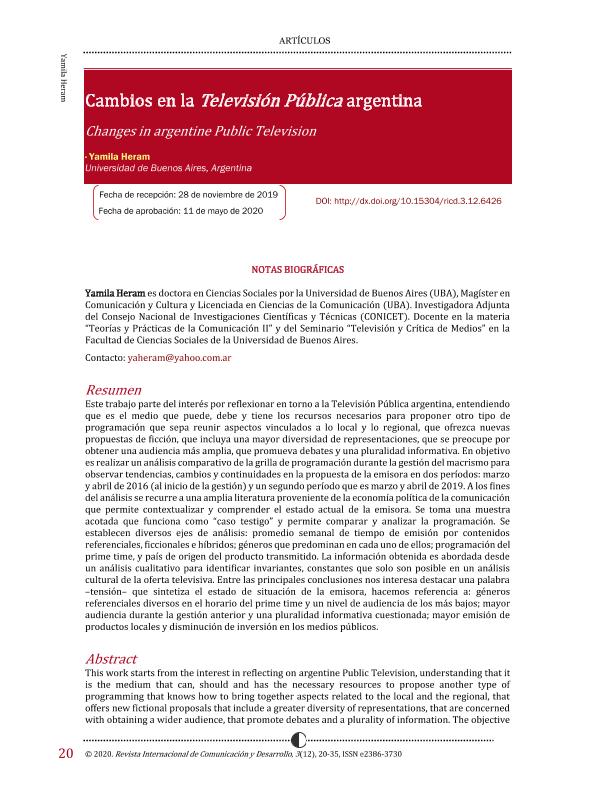Mostrar el registro sencillo del ítem
dc.contributor.author
Heram, Yamila

dc.date.available
2022-09-15T20:02:11Z
dc.date.issued
2020-08
dc.identifier.citation
Heram, Yamila; Cambios en la Televisión Pública argentina; Universidad de Santiago de Compostela; Internacional de Comunicación y Desarrollo; 3; 12; 8-2020; 20-35
dc.identifier.uri
http://hdl.handle.net/11336/169020
dc.description.abstract
Este trabajo parte del interés por reflexionar en torno a la Televisión Pública argentina, entendiendo que es el medio que puede, debe y tiene los recursos necesarios para proponer otro tipo de programación que sepa reunir aspectos vinculados a lo local y lo regional, que ofrezca nuevas propuestas de ficción, que incluya una mayor diversidad de representaciones, que se preocupe por obtener una audiencia más amplia, que promueva debates y una pluralidad informativa. En objetivo es realizar un análisis comparativo de la grilla de programación durante la gestión del macrismo para observar tendencias, cambios y continuidades en la propuesta de la emisora en dos períodos: marzo y abril de 2016 (al inicio de la gestión) y un segundo período que es marzo y abril de 2019. A los fines del análisis se recurre a una amplia literatura proveniente de la economía política de la comunicación que permite contextualizar y comprender el estado actual de la emisora. Se toma una muestra acotada que funciona como “caso testigo” y permite comparar y analizar la programación. Se establecen diversos ejes de análisis: promedio semanal de tiempo de emisión por contenidos referenciales, ficcionales e híbridos; géneros que predominan en cada uno de ellos; programación del prime time, y país de origen del producto transmitido. La información obtenida es abordada desde un análisis cualitativo para identificar invariantes, constantes que solo son posible en un análisis cultural de la oferta televisiva. Entre las principales conclusiones nos interesa destacar una palabra –tensión– que sintetiza el estado de situación de la emisora, hacemos referencia a: géneros referenciales diversos en el horario del prime time y un nivel de audiencia de los más bajos; mayor audiencia durante la gestión anterior y una pluralidad informativa cuestionada; mayor emisión de productos locales y disminución de inversión en los medios públicos.
dc.description.abstract
This work starts from the interest in reflecting on argentine Public Television, understanding that it is the medium that can, should and has the necessary resources to propose another type of programming that knows how to bring together aspects related to the local and the regional, that offers new fictional proposals that include a greater diversity of representations, that are concerned with obtaining a wider audience, that promote debates and a plurality of information. The objective is to carry out a comparative analysis of the programming grid during the management of the macrismo to observe trends, changes and continuities in the station's proposal in two periods: March and April 2016 (at the beginning of the management) and a second period which is March and April 2019. For the purposes of the analysis, a broad literature from the political economy of communication is used, which allows contextualizing and understanding the current state of the station. A bounded sample is taken that functions as a "control case" and allows the programming to be compared and analyzed. Various analysis axes are established: weekly average of broadcasting time by referential, functional and hybrid content; genres that predominate in each of them; prime time programming, and country of origin of the transmitted product. The information obtained is approached from a qualitative analysis to identify invariants, constants that are only possible in a cultural analysis of the television offer. Among the main conclusions we are interested in highlighting a word -voltage- that synthesizes the state of the station, we refer to: different referential genres in prime time and a low audience level; greater audience during the previous administration and a questioned plurality of information; higher emission of local products and decreased investment in public media.
dc.format
application/pdf
dc.language.iso
spa
dc.publisher
Universidad de Santiago de Compostela
dc.rights
info:eu-repo/semantics/openAccess
dc.rights.uri
https://creativecommons.org/licenses/by-nc-nd/2.5/ar/
dc.subject
TELEVISIÓN PÚBLICA
dc.subject
GRILLA DE PROGRAMACIÓN
dc.subject
MEDIOS PÚBLICOS
dc.subject
MACRISMO
dc.subject.classification
Otras Comunicación y Medios

dc.subject.classification
Comunicación y Medios

dc.subject.classification
CIENCIAS SOCIALES

dc.title
Cambios en la Televisión Pública argentina
dc.title
Changes in argentine Public Television
dc.type
info:eu-repo/semantics/article
dc.type
info:ar-repo/semantics/artículo
dc.type
info:eu-repo/semantics/publishedVersion
dc.date.updated
2022-09-15T14:56:40Z
dc.identifier.eissn
2386-3730
dc.journal.volume
3
dc.journal.number
12
dc.journal.pagination
20-35
dc.journal.pais
España

dc.journal.ciudad
Santiago de Compostela
dc.description.fil
Fil: Heram, Yamila. Consejo Nacional de Investigaciones Científicas y Técnicas; Argentina. Universidad de Buenos Aires. Facultad de Ciencias Sociales. Instituto de Investigaciones "Gino Germani"; Argentina
dc.journal.title
Internacional de Comunicación y Desarrollo
dc.relation.alternativeid
info:eu-repo/semantics/altIdentifier/url/https://revistas.usc.gal/index.php/ricd/article/view/6426
dc.relation.alternativeid
info:eu-repo/semantics/altIdentifier/doi/http://dx.doi.org/10.15304/ricd.3.12.6426
Archivos asociados
